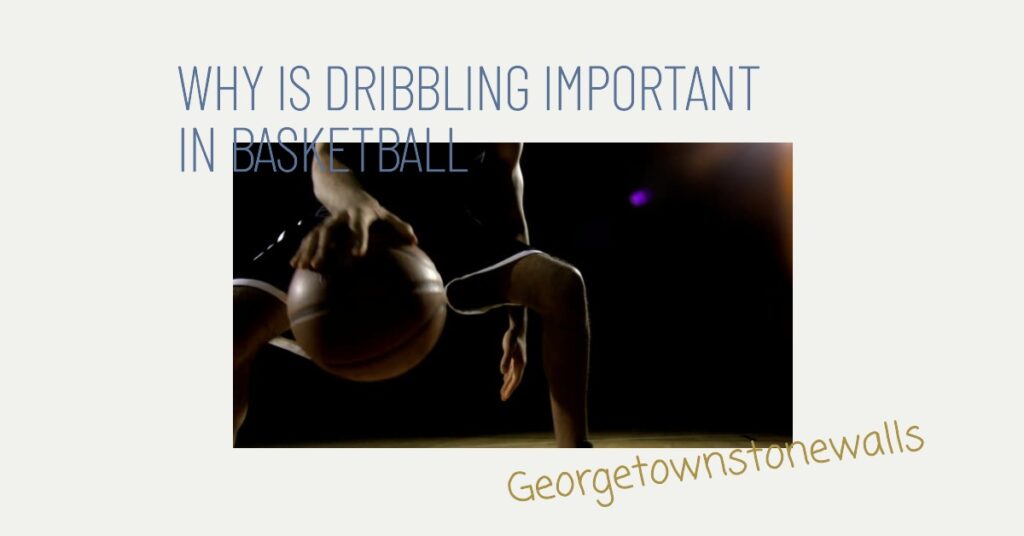Dribbling in basketball is crucial as it enables players to move the ball effectively on the court. It allows for maintaining possession, navigating through defenses, and setting up scoring opportunities.
Dribbling is to basketball what steering is to driving; it’s how players direct the flow of the game, maneuver around opponents, and retain control under pressure. Mastering the dribble opens up the court and gives players the freedom to execute plays, make decisive movements towards the basket, and adapt to defensive challenges.
It’s a skill that combines coordination, agility, and strategic thinking, making it indispensable for basketball success. Skilled dribblers can change the game’s momentum, creating advantages that can lead to victories on the court.
The Fundamentals Of Dribbling
Dribbling is not just a mere action in basketball; it is a critical component that separates good players from great ones. The ability to control the ball effectively and move with purpose on the court hinges upon proficient dribbling skills. Mastery of dribbling benefits both offensive play and strategic defense, making it a foundational skill for any player.
Basic Description And Purpose Of Dribbling
In basketball, dribbling is the technique of continuously bouncing the ball on the court, allowing a player to move while maintaining possession. This action must be done using one hand, with fingertips rather than the palm, to ensure better control. The purpose of dribbling can be summarized as follows:
- Movement: Dribbling allows for player mobility while observing the rules against traveling.
- Control: It provides players with the means to maintain possession and manage the pace of the game.
- Defense Break: Skilled dribblers can evade defenders, creating opportunities for scoring or passing.
How It Differentiates Basketball From Other Sports
Dribbling is a distinctive feature of basketball; it sets the sport apart from other team games where the ball is predominantly controlled by the feet or hands but not bounced. In comparison:
| Sport | Ball Control Method |
|---|---|
| Basketball | Dribbling with hands |
| Soccer | Dribbling with feet |
| Rugby | Carrying and passing |
The rule-bound nature of dribbling in basketball—such as the prohibition of carrying or using two hands—further differentiates it. These unique regulations emphasize skillful handling and agility, making basketball a sport where precise and strategic ball control through dribbling is not just important, but essential.
Dribbling And Ball Control
In the dynamic world of basketball, dribbling emerges as a critical skill that can make or break a player’s effectiveness on the court. Mastery of this skill allows for superior ball control, setting the stage for offensive plays and defensive maneuvers. Understanding the nuances of this technique not only enhances a player’s repertoire but also elevates the overall strategy of the team. Below, we’ll dissect the intimate relationship between dribbling and ball control and how this synergy is essential for success in basketball.
The Relationship Between Dribbling And Ball Control
Dribbling and ball control are two sides of the same coin in the basketball universe. Dribbling is not merely about bouncing the ball but encompasses the ability to maintain possession under pressure and navigate through the defense. A tight control on the ball ensures a player can:
- Evade defenders with ease
- Change speed and direction fluidly
- Create scoring opportunities for themselves and teammates
Ball control is the foundation upon which dribbling skills are built. It requires a blend of hand-eye coordination, balance, and spatial awareness. As players refine their dribbling, their control over the ball improves, leading to less turnovers and better game management.
How Dribbling Influences Player Movement And Technique
Dribbling dictates a player’s movement across the court and impacts their overall technique. Here’s how proficient dribbling can transform a player’s game:
| Aspect of Movement/Technique | Influence of Dribbling |
|---|---|
| Agility and Quickness | Enhances ability to make sharp cuts and rapid transitions |
| Handling Pressure | Facilitates composure when trapped or double-teamed |
| Offensive Strategy | Enables execution of complex plays and effecting drive-and-kicks |
Players with exceptional dribbling skills have the ability to guide their movement with purpose, making them unpredictable and difficult to guard. This proficiency also includes an array of dribbling techniques such as crossovers, behind-the-back moves, and spins, which are crucial for outmaneuvering opponents.
Ultimately, superior dribbling proficiency leads to increased confidence and allows for more creative playmaking. A player who can control the ball effectively under pressure is invaluable in tight situations, making dribbling a cornerstone of basketball prowess.
Dribbling And Offensive Strategy
Dribbling in basketball is not just a flashy skill; it’s a critical component of any successful offensive strategy. It allows players to navigate the court, dictate the pace of the game, and exploit defensive weaknesses. Effective dribbling creates space, syncs with team dynamics, and sets the foundation for scoring opportunities. Let’s dive into the pivotal role dribbling plays in offensive execution.
Impact Of Dribbling On Offensive Plays
Dribbling directly influences the formation and execution of offensive plays. With the ball in hand, a player can:
- Initiate offensive setups, moving the ball into advantageous positions.
- Create mismatches by drawing out defenders and opening passing lanes.
- Control tempo, speeding up or slowing down play based on the team’s strategy.
The capability to maintain ball possession and maneuver effectively through defensive pressure is essential for running complex plays that keep the opposing team guessing. A strong dribbler can manage a seamless transition from defense to offense, orchestrating the team’s approach and leading to high-percentage shots.
The Importance Of Dribbling In Setting Up Scoring Opportunities
A well-executed dribble can be the prelude to a game-changing score. Strategic dribbling serves to:
- Penetrate defenses, creating lanes to either take the shot or dish the ball to an open teammate.
- Attract additional defenders, thereby freeing up teammates for uncontested shots.
- Disturb defensive alignments, which can result in advantageous one-on-one situations.
By mastering dribbling, players gain the ability to craft high-quality scoring chances out of thin air — often under tight pressure. The unpredictability and agility provided by adept dribbling can dismantle even the most organized defensive schemes, leading to those thrilling moments that define the sport.

Defensive Considerations And Dribbling
Understanding the relationship between dribbling and defensive play is crucial for any basketball player. Defense in basketball isn’t just about reacting to shots; it’s also about anticipating dribble moves and cutting off the opponent’s path. Mastering defensive strategies against accomplished dribblers can drastically reduce the other team’s scoring opportunities, making it an integral part of the game.
How Dribbling Influences Defensive Strategies
Defensive tactics are substantially affected by an opponent’s dribbling skills. Players must constantly adapt and adjust their positioning to counteract the offense’s maneuvers. The following points illustrate the impact of dribbling on defense:
- Pressure Application: Defenders must apply pressure without overcommitting, which requires excellent footwork and spatial awareness.
- Forcing Direction: By predicting dribble patterns, defenders can force ball handlers towards the sideline or into less advantageous positions.
- Balancing Risk and Reward: Attempts to steal can leave a defender out of position, so there’s a need to be judicious in choosing when to reach for the ball.
Defending Against Skilled Dribblers
Challenging a proficient dribbler calls for a blend of physical prowess and strategic thinking. Defenders face various scenarios:
| Defensive Scenario | Defensive Strategy |
|---|---|
| Isolation Plays | Maintain a low center of gravity and stay on the balls of the feet to react quickly to direction changes. |
| Pick and Roll Situations | Communication with teammates is key to decide on switching, hedging, or trapping the ball handler. |
| Fast Break Attack | Prioritize stopping the ball and force the dribbler towards teammates who can help contain the advance. |
Tools like lateral quickness, active hands, and the ability to read the dribbler’s body language are essential for defenders. Moreover, successful defense against dribbling can transition into effective offense, capitalizing on turnovers and opponents’ mistakes.
The Psychological Advantage Of Superior Dribbling
In the high-octane world of basketball, where every second counts and every move is watched, dribbling is not just a skill, it’s an art form that can set the stage for success. Players known for their superior dribbling abilities become imposing figures on the court. Let’s break down the psychological advantage of exceptional dribbling skills and how they contribute to both personal and team triumph.
Impact Of Strong Dribbling Skills On Player Confidence
Confidence can be the deciding factor in crucial game situations. Possessing strong dribbling skills arms players with the self-assurance needed to face any defender. Let’s explore how adept ball-handling boosts a player’s confidence:
- Enhanced Control: Mastery of dribbling allows a player to navigate through tight defenses, increasing control over game tempo.
- Readiness: A confident dribbler is always game-ready, anticipating defensive strategies and adapting swiftly.
- Leadership: Skilled dribblers often find themselves in leadership roles, driving plays and inspiring teammates.
The Mental Edge Gained Through Exceptional Dribbling Abilities
Exceptional dribbling spills over from physical prowess to mental dominance. The psychological leverage gained from dribbling proficiency can be profound:
- Psyching Out Opponents: Dribblers with deft moves can intimidate and destabilize their opponents’ strategy.
- Boosting Team Morale: When one player demonstrates expert control, it lifts the entire team’s performance.
- Stress Reduction: Players who dribble well often feel less pressure, allowing them to focus on making strategic plays.
Understanding and honing the psychological facets of dribbling can make the difference between a good basketball player and a great one.
Frequently Asked Questions For Why Is Dribbling Important In Basketball
What Is Dribbling In Basketball And Why Is It Important?
Dribbling in basketball is the act of bouncing the ball while moving. It’s vital for maintaining possession and maneuvering around opponents to score.
Why Do We Dribble The Ball?
We dribble the ball to maintain possession, navigate the court, and evade defenders in order to score.
Is Dribbling Needed In Order To Be Successful In Basketball?
Yes, dribbling is vital for success in basketball as it enables ball advancement, playmaking, and maintaining possession.
Is Passing More Important Than Dribbling In Basketball?
Dribbling and passing are both crucial skills in basketball. Neither is inherently more important; their use depends on the play situation. Effective basketball requires a balance of passing to move the ball quickly and dribbling to navigate through defenders.
Conclusion
Mastering dribbling is not just a skill; it’s a game-changer. It enables players to navigate the court, maintain possession, and assert control during the game. Through effective dribbling, basketball players can create scoring opportunities and support their team’s offensive strategies.
As we’ve explored, proficient dribbling contributes to both individual and team success on the court. Remember, it’s the player who can deftly handle the ball under pressure who often leads the game to victory. Keep practicing and let your dribbling skills pave the way to excellence in basketball.


